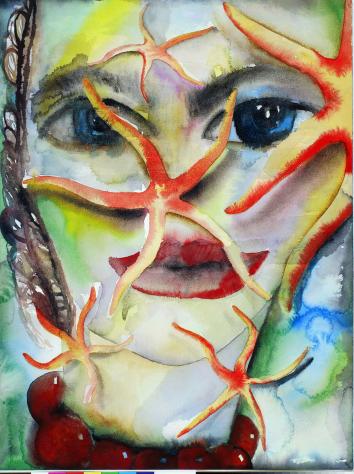Francesco Clemente
dal 3/2/2004 al 25/4/2004
Segnalato da
3/2/2004
Francesco Clemente
Irish Museum of Modern Art - IMMA, Dublin
New Works comprises more than 60 works, including some 20 paintings, 10 pastels and 30 watercolours. All have been created since Clemente's comprehensive retrospective at the Guggenheim, New York, in 1999 and most are being shown publicly for the first time.

The first major exhibition in Ireland by the internationally-acclaimed Italian
artist Francesco Clemente opens to the public at the Irish Museum of Modern Art
on Wednesday 4 February 2004. Francesco Clemente: New Works comprises more than
60 works, including some 20 paintings, 10 pastels and 30 watercolours. All have
been created since Clemente's comprehensive retrospective at the Guggenheim, New
York, in 1999 and most are being shown publicly for the first time. The
exhibition is presented in association with THE IRISH TIMES.
Francesco Clemente first came to international attention as part of the Italian
Transavanguardia group in the late 1970s and early '80s, a period which saw a
renewed interest in painting internationally, evident in the success of artists
such as Julian Schnabel and Anselm Kiefer.
From the start, however, Clemente
manifested a singular personal vision, drawing on a diverse cross section of
cultures and styles to realise his wide range of visual and conceptual ideas.
Extensive travels in Europe, the Caribbean, Egypt, Japan, New Mexico and, in
particular, in India, have been a major influence, releasing him from the usual
conventions of art making.
One defining characteristic of Clemente's work, which sets him apart from many
of his contemporaries, is the way in which he synthesises, rather than
juxtaposes, these different influences into a rich and complex oeuvre which is
completely his own. Another is his perception of the human body as a membrane
of experience, both physical and intellectual. Francesco Pellizzi, editor of
the aesthetics and anthropology journal Res, describes Clemente's work as
"making us newly aware of the connection between the outer surface of our skin
and the inner one of our world, the world of our enveloping cave or womb."
This view, of Clemente as an artist unlike any other, is one which recurs again
and again in evaluations of his work. Writing in the catalogue to the
Guggenheim show, its curator Lisa Dennison concludes: "Clemente has made a new
and unique contribution to the art and culture of his times. His method is
contemplative, meditative, and indulgent. He maintains a fantastical, exotic
vision, even when dealing with the commonplace. The paradoxes in his work - the
blurring of boundaries between interior and exterior, between self and others,
between the physical and psychical - are what sustain its interest for us most
deeply, and what continually open up its possibilities for the future."
The recent works on show at IMMA include images of the human body and also of
everyday objects, such as stairs, wheels, vases and animals. Vincent Katz in
his text for the catalogue of the show says about the paintings: "Though they
employ recognisable subjects, they are not realistic; they do not partake of
realistic spaces or even classical perspective. Serenity is one of a group of
works that make use of house of cards imagery to suggest the instability of life
and also the significance of chance.... Equanimity is a tantilising image, a
boat filling with water in the foreground suggests a smiling mouth, while books
or newspapers fly against a wall and land on the surface of the water, which
suddenly appears to be a solid floor."
Born in Naples to a professional family in 1952, Francesco Clemente had already
begun his life-long travels by the age of two, visiting museums, churches and
palaces throughout Europe with his parents. In 1970 he moved to Rome to study
architecture, but lost interest before taking his final examination turning
instead to drawing and poetry. In 1973 he made the first of many visits to
India, a country whose culture and philosophy was to have an immense influence
on his work.
In 1975 he had solo exhibitions in Brescia, Milan and Turin and a group show in
Rome. At the Venice Biennale in 1980, Clemente commanded the attention of an
international audience and following this went on to play an influential part in
the international revival of Expressionism in the 1970s. Numerous exhibitions
followed, including the Whitechapel, London, (1983); the Nationalgalerie,
Berlin, (1984); the Fundacion Caja, Madrid, (1987); the Dia Art Foundation, New
York, (1988-90); the Sezon Musuem, Tokyo, (1994); Helsingin Taidehalli,
Helsinki, (1995) and the Metropolitan Museum, New York, (1997).
Francesco Clemente: New Works continues until 25 April 2004.
Admission is free.
A fully-illustrated catalogue with essays by Enrique Juncosa, Director of IMMA
and curator of the show, Lisa Phillips, Director of New Museum of Contemporary
Art, New York, and Vincent Katz, poet and writer, accompanies the exhibition.
The exhibition has been co-produced with the Reykjavik Art Museum, Iceland.
Image: Francesco Clemente, Water, Taormina 2003, Private Collection, Courtesy
Galerie Bruno Bischofberger, Zurich. Photo: Greg Fuchs
Opening hours: Tue - Sat 10.00am -
5.30pm
Sun and Bank Holidays 12 noon - 5.30pm
Mondays and 9 April Closed
For further information and colour and black and white images please contact
Monica Cullinane or Patrice Molloy at Tel : +353 1 612 9900, Fax : +353 1 612
9999,
Irish Museum of Modern Art
Royal Hospital Military Road Kilmainham 8
Dublin



